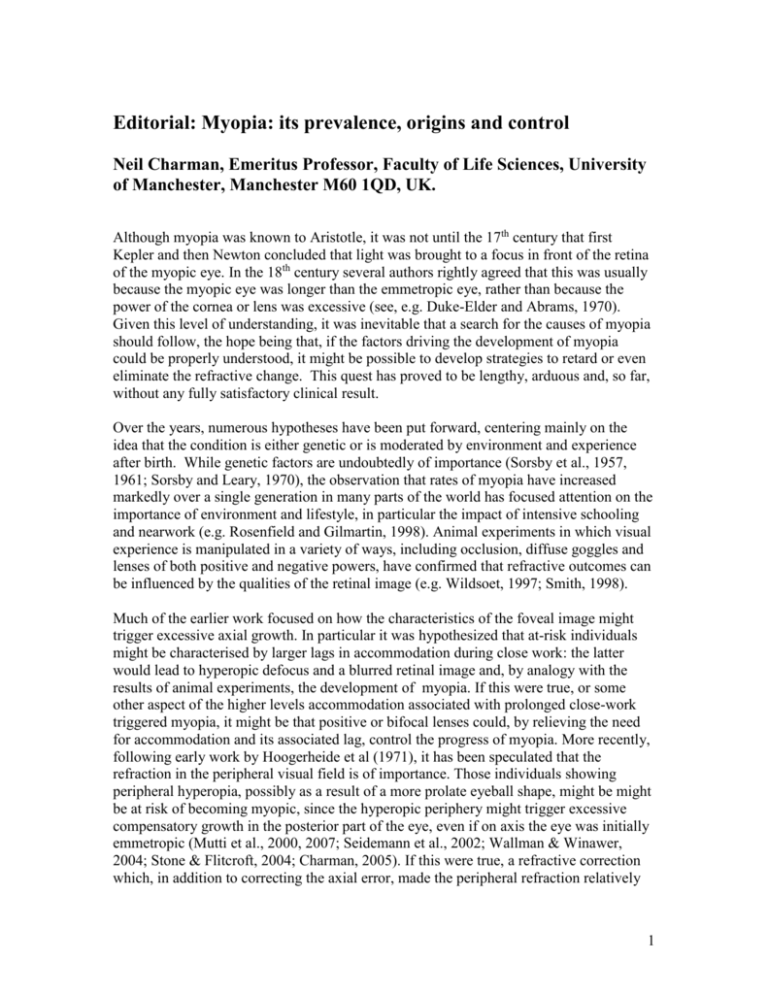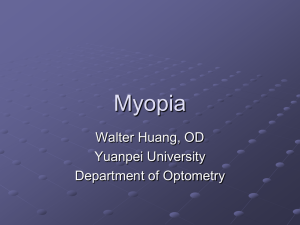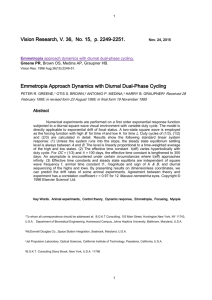Editorial: Myopia
advertisement

Editorial: Myopia: its prevalence, origins and control Neil Charman, Emeritus Professor, Faculty of Life Sciences, University of Manchester, Manchester M60 1QD, UK. Although myopia was known to Aristotle, it was not until the 17th century that first Kepler and then Newton concluded that light was brought to a focus in front of the retina of the myopic eye. In the 18th century several authors rightly agreed that this was usually because the myopic eye was longer than the emmetropic eye, rather than because the power of the cornea or lens was excessive (see, e.g. Duke-Elder and Abrams, 1970). Given this level of understanding, it was inevitable that a search for the causes of myopia should follow, the hope being that, if the factors driving the development of myopia could be properly understood, it might be possible to develop strategies to retard or even eliminate the refractive change. This quest has proved to be lengthy, arduous and, so far, without any fully satisfactory clinical result. Over the years, numerous hypotheses have been put forward, centering mainly on the idea that the condition is either genetic or is moderated by environment and experience after birth. While genetic factors are undoubtedly of importance (Sorsby et al., 1957, 1961; Sorsby and Leary, 1970), the observation that rates of myopia have increased markedly over a single generation in many parts of the world has focused attention on the importance of environment and lifestyle, in particular the impact of intensive schooling and nearwork (e.g. Rosenfield and Gilmartin, 1998). Animal experiments in which visual experience is manipulated in a variety of ways, including occlusion, diffuse goggles and lenses of both positive and negative powers, have confirmed that refractive outcomes can be influenced by the qualities of the retinal image (e.g. Wildsoet, 1997; Smith, 1998). Much of the earlier work focused on how the characteristics of the foveal image might trigger excessive axial growth. In particular it was hypothesized that at-risk individuals might be characterised by larger lags in accommodation during close work: the latter would lead to hyperopic defocus and a blurred retinal image and, by analogy with the results of animal experiments, the development of myopia. If this were true, or some other aspect of the higher levels accommodation associated with prolonged close-work triggered myopia, it might be that positive or bifocal lenses could, by relieving the need for accommodation and its associated lag, control the progress of myopia. More recently, following early work by Hoogerheide et al (1971), it has been speculated that the refraction in the peripheral visual field is of importance. Those individuals showing peripheral hyperopia, possibly as a result of a more prolate eyeball shape, might be might be at risk of becoming myopic, since the hyperopic periphery might trigger excessive compensatory growth in the posterior part of the eye, even if on axis the eye was initially emmetropic (Mutti et al., 2000, 2007; Seidemann et al., 2002; Wallman & Winawer, 2004; Stone & Flitcroft, 2004; Charman, 2005). If this were true, a refractive correction which, in addition to correcting the axial error, made the peripheral refraction relatively 1 myopic would be beneficial. Animal experiments appear to support the possibility that peripheral error influences axial refractive development (e.g. Smith et al., 2009). This virtual issue contains a collection of recent (post-January 2007) papers from Ophthalmic and Physiological Optics which relate to these basic ideas. Several papers are directly concerned with the prevalence and development of school-age myopia. Czepita et al. (2007) explore the refractive errors in a population of over 4000 Polish schoolchildren and find, as expected, a gradual increase in myopia with age between 6 and 18 years, with an overall prevalence of about 13%. Plainis et al. (2009) compare the proportions of school children with myopia and reduced visual acuity in Greece and Bulgaria. In spite of the relatively close geographical proximity of the two populations, rates of myopia are markedly higher in the Greek children, emphasising the need for careful consideration of environmental and socio-economic factors when interpreting data for myopia prevalence. Saw et al. (2007) consider myopia in relation to a different metric, academic achievement at school, and find a positive association: they speculate that this may either be due to longer hours of close work or, perhaps, an association between myopia and intelligence. A further group of papers relates directly to the effects of nearwork. Weizhong et al. (2008), in a one-year longitudinal study, explore the question as to whether there is a relationship between accommodative lag and myopia development in 11 year-old Chinese children. They find that the initial accommodative lag has no correlation with myopia progression or increase in axial length. Nevertheless, the same research group has also evaluated the utility of progressive addition lenses (PALs) in slowing myopia development (Yang et al., 2009). In a two-year longitudinal study of children aged 7-13 years with low initial myopia (-0.50 to -3.00 D), they find that those children wearing PALs experienced slightly smaller increases in myopia and axial length than those children whose myopia was corrected with single-vision lenses. The differences in myopic change were, however, relatively modest (overall shifts of about -1.25 D in the PAL group compared with about -1.50D in the single-vision group). Two further shortterm studies examine different aspects of possible bifocal corrections for myopes. Cheng et al. (2008) determine the effects of different combinations of positive lenses and basein prisms on accommodation accuracy and near phoria in young Chinese myopes and find that a combination of +2.25D with 6Δ of base-in prism has the greatest beneficial effect on the accommodation and phoria. A subsequent 2-year trial by this group suggests that prismatic bifocals may usefully slow the progress of myopia (Cheng et al., 2010). Accommodation errors in young myopic and emmetropic adults wearing a different form of correction, soft contact lenses, are studied by Tarrant et al. (2008): monocular and binocular accommodation performance with single-vision corrections for distance and near is compared with that obtained with simultaneous-vision, bifocal contact lenses. As in earlier studies, when wearing single-vision distance corrections myopes are found to exhibit greater errors in accommodation than emmetropes: however, the lags at near and differences between refractive groups are eliminated when single vision near corrections are worn., albeit at the expense of over-accommodation for distance targets. Similar levels of accommodative lag in myopes and emmetropes could 2 still lead to greater levels of retinal blur in myopes if their pupils were systematically larger: however, Charman and Radhakrishnan (2009) find no evidence for any differences between the two refractive groups in either absolute pupil diameter or its changes with accommodation. The last paper of this group is a thoughtful review of the evidence for a possible link between nearwork-induced transient myopia (NITM) and permanent myopia (Ciuffreda and Vasudevan, 2008): it appears that this link may be real. Particularly interesting features of their analysis of the relevant literature are the findings that progressing myopes may be more susceptible to NITM, that myopic defocus caused by under-correction may be myopigenic, and that breaks in close work to allow periods of distance vision may be helpful. The general question of the relationship between peripheral refraction and the development of refractive error, together with evidence for the sensitivity of the peripheral retina to defocus, is reviewed by Charman and Radhakrishnan (2010). A number of groups have studied aspects of the experimental measurement of peripheral refractive error in relation to myopia. The first of these (Bernstein et al., 2008) considers measurement techniques. The authors show that measurements of peripheral refraction made with a Shack-Hartmann aberrometer are equivalent to those made with a conventional autorefractor, so that it is possible to use an aberrometer to simultaneously collect measurements of refraction and aberration. They find that relative peripheral hyperopia at 30 deg field angle tends to increase with the axial myopia, although values for the nasal retina are higher than for the temporal retina. There is, however, a wide range of scatter between individual subjects, with a substantial proportion of even quite high myopes (up to -9 D) showing relative myopia rather than hyperopia in at least one semi-meridian of the peripheral field (see also, e.g. Chen X. et al., 2010). These findings may help to explain the findings of Calver et al. (2007) who find little difference between myopes and emmetropes in their patterns of refraction over the central ±30 deg of horizontal visual field, during either distance or near (40 cm) vision. It is, of course, important to remember that in the eye oblique astigmatism increases steadily with peripheral angle, so that the question of what constitutes the “best” image surface is more complex than would be the case if the peripheral errors were purely spherical (Charman and Atchison, 2008). One intriguing question relating to both peripheral and axial refraction is whether the variations in the forces acting on the eyeball caused by changes in the direction of gaze might influence eyeball shape, corneal topography, refraction and aberration, in either the short or longer term. Such forces might be due to the extraocular muscles, lid tension and other factors. The idea that external forces might be involved in myopia development has a long pedigree, dating back at least to the time of Donders (1864). However, Radhakrishnan and Charman (2008) find no differences between the refractive results obtained over the central ±30 of horizontal field when the eye is either turned to make the measurements or is kept in the straight-ahead position and the head turned, even though the forces on the eyeball differ markedly in the two conditions. These results are supported by those of a careful similar study over the central ±34 deg of horizontal field, using a larger group of cyclopleged myopic and emmetropic subjects (Mathur et al., 2009). Further, Prado et al. (2009) find no changes in axial aberrations when the gaze 3 direction is varied. Thus short periods (a few minutes) of oblique viewing do not appear to change either the shape of the eyeball or that of its optical surfaces, although the possibility that stresses maintained over longer periods might have some effect cannot be dismissed (Buehren et al., 2003). Further development of methods of measuring changes in axial length and eyeball shape by optical coherence tomography should be helpful in exploring further the shape of the eyeball and its changes under various conditions (Mallen and Kashyap, 2007). A last group of papers relates to aspects of ocular corrections and peripheral refraction which may have relevance to the control of myopia progression. Two recent studies have found that rates of myopia progression and growth in axial length are reduced in children whose errors are corrected by orthokeratology rather than conventional single-vision spectacles (Cho et al., 2005; Walline et al., 2009). It has been suggested that this is because correction by ortho-K has the advantage that it maintains the myopic refraction of the peripheral retina, while also correcting the axial error (Charman et al., 2006). If indeed orthokeratology has an important role to play in reducing myopia progression, rather than merely temporarily correcting the existing error, it is important that its shortand long-term effects be understood as fully as possible. In this issue Lu et al. (2007) explore the effects of treatment zone diameter, while Chen D. et al. (2009, 2010) consider biomechanical changes and posterior corneal curvature changes. The study on hyperopic orthokeratology by Gifford and Swarbrick (2009) allows a useful comparison between the effects of treatment for different types of refractive error. A final paper (Bakaraju et al., 2008) reminds us that conventional spectacle corrections do more than simply correct the axial refractive error: they also change the pattern of peripheral refraction. Moreover this pattern of change will vary with the pantoscopic tilt of the lenses. Using ray-tracing, Bararaju et al. demonstrate that with high myopic prescriptions considerable non-uniform hypropic shifts may be produced in the peripheral field, as well as additional astigmatism and coma (see also Lin et al., 2010, for practical measurements). Such effects will thus need careful consideration if further work confirms a link between myopia progression and peripheral refraction. Any reader interested in the problems of myopia, its incidence and its progression will, then, find much to enjoy in this virtual issue. Although, as yet, we have not found the path to a complete solution of these problems, some partial progress has been made and some promising routes have been mapped out for future research References Bakaraju, R.C., Ehrmann, K., Ho, A. and Papas, E.B. (2008) Pantoscopic tilt in spectaclecorrected myopia and its effect on peripheral refraction. Ophthal.Physiol.Opt. 28, 538549. 4 Berntsen, D.A., Mutti, D.O. and Zadnik, K. (2008) Validation of aberrometry-based relative peripheral refraction measurements. Ophthal. Physiol. Opt. 28, 83-90. Buehren, T., Collins, M.J., and Carney (2003) Corneal aberrations and reading. Optom.Vis.Sci. 80, 159-166. Calver, R., Radhakrishnan, H., Osuobeni, E. and O’Leary, D. (2007) Peripheral refraction for distance and nerar vision in emmetropes and myopes. Ophthal.Physiol.Opt. 27, 584593. Charman, W.N. (2005) Aberrations and myopia. Ophthal. Physiol. Opt. 25, 285-301. Charman, W.N. and Atchison, D.A. (2008) Optimal spherical focus in the peripheral retina. Ophthal.Physiol.Opt. 28, 269-276. Charman, W.N. and Radhakrishnan, H. (2009) Accommodation, pupil diameter and myopia. Ophthal.Physiol.Opt. 29, 72-79. Charman, W.N. and Radhakrishnan, H. (2010) Peripheral refraction and the development of refractive error: a review. Ophthal.Physiol.Opt. 30, ***** Charman, W.N., Mountford, J., Atchison, D.A. and Markwell, E.L. (2006) Peripheral refraction in orthokeratology patients. Optom.Vis.Sci. 83, 641-648. Chen, D., Lam, A.K.C. and Cho, P. (2009) A pilot study on the biomechanical changes in short-term orthokeratology. Ophthal.Physiol.Opt. 29, 464-471. Chen, D., Lam, A.K.C. and Cho, P.(2010) Posterior corneal curvature change and recovery after 6 months of overnight orthokeratology treatment. Ophthal.Physiol.Opt. 30, 274-280. Chen, X., Sankaridurg, P., Donovan, L., Lin, Z., Li, L., Martinez, A., Holden, B. and Ge, J. (2010) Characteristics of peripheral refractive errors of myopic and non-myopic Chinese eyes. Vision Res. 50, 31-35. Cheng, D., Schmidt, K.L. and Woo, G.C. (2008) The effect of positive-lens addition and base-in prism on accommodation accuracy and near horizontal phoria in Chinese myopic children. Ophthal.Physiol.Opt. 28, 225-237. Cheng, D., Schmid, K.L., Woo, G.C. and Drobe, B. (2010) Randomized trial of effect of bifocal and prismatic bifocal spectacles on myopic progression. Arch.Ophthalmol. 128, 12-19. Cho, P., Cheng, S.W. and Edwards, M. (2005) The longitudinal orthokeratology research in children (LORIC) in Hong Kong: a pilot study on refractive changes and myopia control. Curr.Eye Res. 30, 71-80. 5 Ciuffreda, K.J and Vasudevan, B. (2008) Nearwork-induced transient myopia (NITM) and permanent myopia – is there a link? Ophthal.Physiol.Opt. 28, 103-114. Czepita, D., Zejmo, M. and Mojsa, A. (2007) Prevalence of myopia and hyperopia in a population of Polish schoolchildren. Ophthal. Physiol.Opt. 27, 60-65. Donders, F.C. (1864) On the Anomalies of Accommodation and Refraction (W.D.Moore, Trans., p. 343), New Sydenham Society, London. Duke-Elder S, Abrams D. (1970) System of Ophthalmology Vol V: Ophthalmic Optics and Refraction, Kimpton, London, pp.207, 240-241. Gifford, P. and Swarbrick, H.A. (2009) The effect of treatment zone diameter in hyperopic orthokeratology. Ophthal.Physiol.Opt. 29, 584-592. Hoogerheide, J., Rempt ,F. and Hoogenboom, W.P. (1971) Acquired myopia in young pilots. Ophthalmologica 163, 209-215. Lin, Z., Martinez, A., Chen, X., Li, L., Sankaridurg, P., Holden, B.A. and Ge, J. (2010) Peripheral defocus with single-vision spectacle lenses in myopic children. Optom.Vis.Sci. 87, 4-9. Lu, F., Simpson, T., Sorbara, L. and Fonn, D. (2007) The relationship between the treatment zone diameter and visual, optical and subjective performance in Corneal Refractive Therapy lens wearers. Ophthal.Physiol.Opt. 27, 568-578. Mallen, E.A.H. and Kashyap, P. (2007) Measurement of retinal contour and supine axial length using the Zeiss IOLMaster. Ophthal.Physiol.Opt. 27, 404-411. Mathur, A., Atchison, D.A., Kasthurirangan, S., Dietz, N.A., Luong, S.L., Chin, S.P., Lin, W.L. and Hoo, S.W. (2009) The influence of oblique viewing on axial and peripheral refraction for emmetropes and myopes. Ophthal.Physiol.Opt. 29, 155-161. Mutti, D.O., Sholtz, R.I., Friedman, N.E. and Zadnik, K. (2000) Peripheral refraction and ocular shape in children. Invest.Ophthamol.Vis Sci. 41, 1022-1030. Mutti, D.O., Hayes, J.R., Mitchell, G.L., Jones, L.A., Moeschberger, M.L., Cotter, S.A., Kleinstein, R.N., Manny, R.E., Twelker, J.D., Zadnik, K. and CLEERE Study Group (2007) Refractive error, axial length, and relative peripheral refractive error before and after the onset of myopia. Invest.Ophthamol.Vis.Sci. 48, 2510-2519. Plainis, S., Moschandreas, J. Nikolitsa, P., Plevridi E., Giannakopoulou, T., Vitanova, V., Tzatzala, P., Pallikaris, I.G. and Tsilimbaris, M.K. (2009) Myopia and visual acuity impairment: a comparative study of Greek and Bulgarian school children. Ophthal.Physiol.Opt. 29, 312-320. 6 Prado, P., Arines, J., Bará, S., Manzanera, S., Mira-Agudelo, A. (2009) Changes of ocular aberrations with gaze. Ophthal.Physiol.Opt. 29, 264-271. Radhakrishnan, H. and Charman, W.N. (2008) Peripheral refraction measurement: does it matter if one turns the eye or the head? Ophthal.Physiol.Opt. 28, 73-82. Rosenfield M., Gilmartin B. (1998) Editors, Myopia and Nearwork, ButterworthHeinemann, Oxford. Saw, S-M., Cheng, A., Fong, A., Gazzard, G., Tan, D.T.H. and Morgan, I. (2007) School grades and myopia. Ophthal.Physiol.Opt. 27, 126-129. Seidemann, A., Schaeffel, F., Guirao, A., Lopez-Gil, N. and Artal, P. (2002) Peripheral refractive errors in myopic, emmetropic, and hyperopic young subjects. J. Opt. Soc. Am. A 19, 2363-2373. Smith, E.L. (1998) Environmentally induced refractive errors in animals. In: Myopia and Nearwork (eds. M Rosenfield and B Gilmartin) Butterworth-Heinemann, Oxford, Chapter 4, pp. 57-90. Smith, E.L., Hung, L.F. and Huang, J. (2009) Relative peripheral hyperopic defocus alters central refractive development in infant monkeys. Vision Res. 49, 2386-2392. Sorsby, A. and Leary, G.A. (1970) A longitudinal study of refraction and its components during growth. HMSO, London. Sorsby, A., Benjamin, B., Davey, J.B., Sheridan, M. and Tanner, J.M. (1957) Emmetropia and its aberrations. Medical Research Council Special Report series No.293. HMSO, London. Sorsby, A., Benjamin, B. and Sheridan, M. (1961) Refraction and its components during growth of the eye from the age of three. Medical Research Council Special Report Series No.301. HMSO, London. Stone, R.A. and Flitcroft, D.I. (2004) Ocular shape and myopia. Ann. Acad. Med. Singapore 33, 7-15. Tarrant, J., Severson, H. and Wildsoet, C.F. (2008) Accommodation in emmetropic and myopic young adults wearing bifocal soft contact lenses. Ophthal.Physiol.Opt. 28, 62-72. Walline, J.J., Jones, L.A. and Sinnott, L.T. (2009) Corneal reshaping and myopia progression. Br.J.Ophthalmol. 93, 1181-1185. Wallman, J. and Winawer, J. (2004) Homeostasis of eye growth and the question of myopia. Neuron 43, 447-468. 7 Weizhong, L., Zhikuan, Y., Wen, L., Xiang, C. and Jian, G. (2008) A longitudinal study on the relationship between myopia development and near accommodation lag in myopic children. Ophthal.Physiol. Opt. 28, 57-61. Wildsoet, C.F. (1997) Active emmetropization – evidence for its existence and ramifications for clinical practice. Ophthal. Physiol. Opt. 17, 279-290. Yang, Z., Lan, W., Ge, J., Liu, W., Chen, X., Chen, L. and Yu, M. (2009) The effectiveness of progressive addition lenses on the progression of myopia in Chinese children. Ophthal.Physiol.Opt. 29, 41-48. 8







